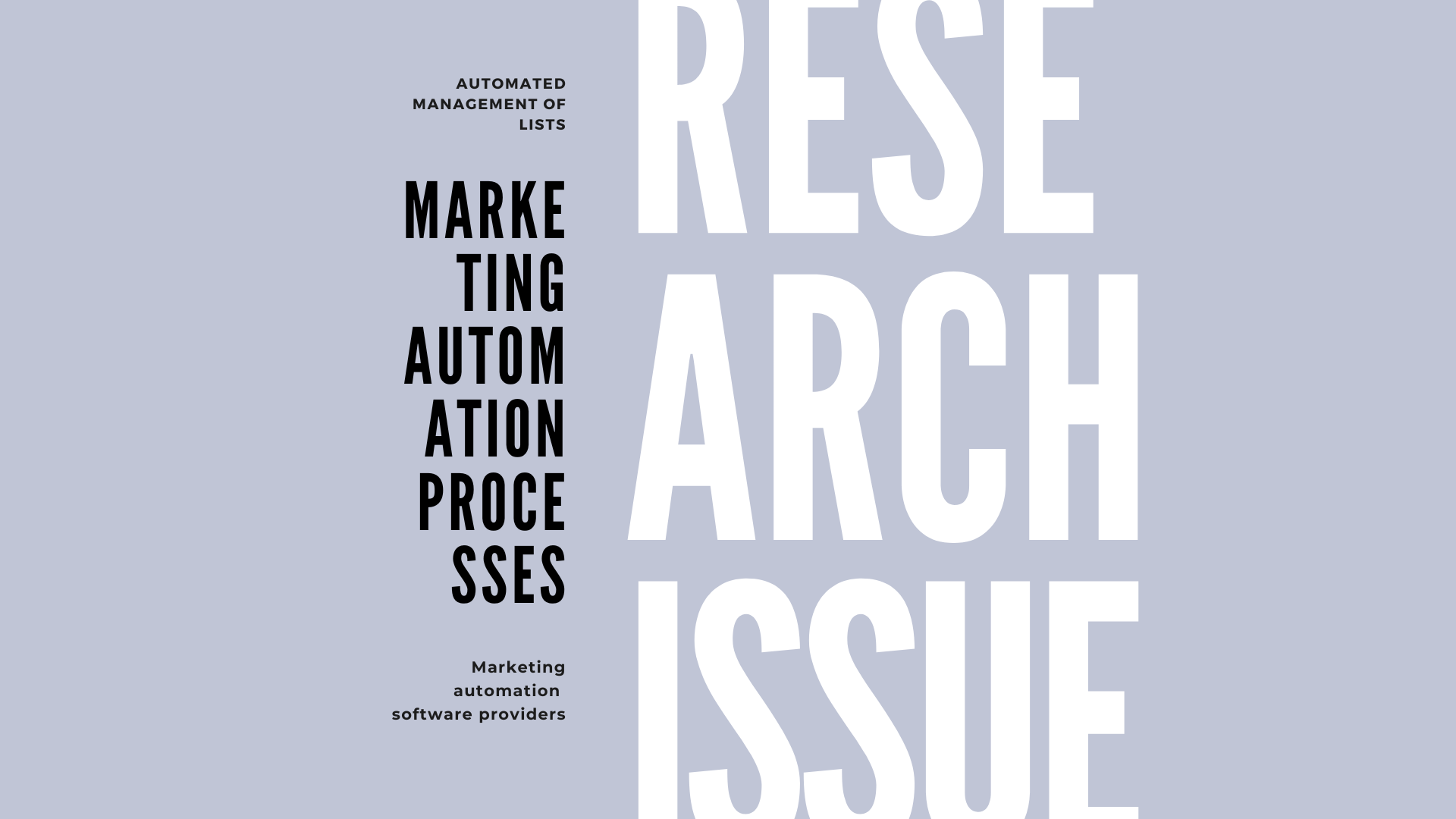Before thinking about automation processes in marketing, it is important to understand why they were developed. One element in particular allows us to understand this clearly: the list. It is a key element in marketing and consists mainly of a file containing contact information such as the name and email address of users who have voluntarily subscribed to a page in order to receive information of interest to them. Usually, this list consists of smaller lists segmented according to the target audience, since today it has been proven that mass mailing is not efficient.
Over time, however, these lists take up a considerable number of contacts, which are constantly being expanded. Not only do these lists involve a large amount of data, but they also involve a multitude of sequential, deadline-driven tasks that can be overwhelming to manage manually. Given this reality, automated management is essential because it is the most efficient way to handle not only the flow of hundreds or even thousands of contacts, but also the tasks that occur during a campaign. These can range from preparing a list, segmenting it, designing the emails, sending them to each audience at a specific date and time, and measuring the metrics to evaluate performance and final performance.
This is where the automation of marketing processes comes into play, through software platforms that facilitate aspects such as writing emails through text editing tools, as well as designing them through templates. Likewise, this type of platform helps in the creation of lists through the automated registration of users who sign up to download an ebook, an infographic or participate in a webinar. On the other hand, these softwares also allow controlling and segmenting an audience, as well as compiling additional information about a prospect, which makes it possible to control and predict the impact of a campaign more accurately.
So It is clear that these are tools that offer various services, which Gunelius [1] says include:
- Writing and designing email marketing through Email Service Providers (ESP).
- Tracking customers through the funnel via marketing automation software providers.
- Sales support through Customer Relationship Management (CRM) software providers that can record all interactions with customers.
Writing and designing of email marketing: Email Service Providers (ESP)
This is specialized software that allows you to easily design messages with a professional look and feel, using plain text or HTML templates created for users who are not skilled in code and for whom it is easier to drag and drop. In many cases, it is as simple as clicking Create, Design, Select Template and dragging the resources to edit the headers, insert images and buttons into the body text or in the footer.

To this design function we must add the send function, which can be programmed with specific messages for each segment of the list, at different dates and at a specific hour for each segment, all of which can be programmed to be executed automatically at a specific time and at a specific hour. The importance of the list and its segmentation into specific target groups is taken into account because in order to program the sending of messages, it is important that each segment is clearly identified.

Perhaps this is the most important function of these software: the automation of the process of sending messages and the synchronization with different contact lists, since it is what has allowed the administration of multiple lists and has opened the possibility of customizing the messages for each particular audience, making communication with customers more effective and personal, which allows reaching those who are really interested, at the right time.
Another important function of these applications is the creation of registration, cancellation or confirmation forms. They can be embedded in a page or appear as pop-up windows. In this case, they are a very useful tool for attracting new subscribers, since they can be activated at the beginning or during the navigation of web pages or blogs to download a lead magnet.

On the other hand, this software lets you measure effectiveness through reports and A/B tests that allow you to see email open rates or content interaction rates. This allows real-time analysis to make corrections in a timely manner. For example, if you want to compare the open rate between two subject line options: with emoji or without emoji, an A/B test can determine which of the two options is more effective and then choose the one whose rate is higher.

For these reasons, this type of software is suitable for marketing and sales teams, as it allows them to automate the workflow and optimize the content of each message based on statistics, which exponentially increases the effectiveness of a campaign.
Tracking Customers Through the Funnel: Marketing Automation Software Providers
In this case, as Pain [2] notes, these are real platforms designed to perform various functions: Managing, executing and automating marketing tasks and processes to overcome the operational constraints imposed by a process as complex and overwhelming as that of sales. According to the author, in the midst of this complexity, three categories can be distinguished in which this automation is applicable:
- Automated Marketing Intelligence: This is the online monitoring of customer and prospect behavior using software with tracking codes that extract, synthesize and analyze publicly available data to create behavioral patterns to better understand the market. SEO and keyword research are a concrete example where we can observe how these platforms work. Website traffic analysis is also a tangible example of how marketing intelligence is automated.

As expected, these processes involve searching thousands and even millions of pieces of data in a matter of seconds and in real time, which would be impossible to do manually. However, these dynamics are harmonized in data dashboards, whose visual attributes facilitate the understanding of numerical data. On the monitors of these dashboards, the progression of one or more variables is displayed in the form of tables, line or bar charts, which helps to quickly understand certain metrics such as views, conversion rate, acceptance, among others[3].

- Business Development Automation: According to Pain [4], business development focuses on the entire marketing funnel, from product awareness at the beginning to closure and loyalty at the end, which includes market segmentation, advertising, conversion and customer management. So it is about automating all the processes of the sales funnel through software that manages aspects such as list creation, segmentation and management, as well as nourishment through email or social networks and even the management of (CRM), all with the aim of optimizing business performance.

As can be seen in the previous image, with these platforms you cannot only create and manage lists, but also each individual contact, since a profile is created for each contact, in which you can access not only basic data such as email, name or phone, but also all interactions, whether by email or call, as well as notes and tasks related to that contact. In other words, these softwares record each sales process individually, from the beginning to the end of the funnel. All of this information is brought together to create a profile that reveals a customer's preferences and allows for more direct and personalized communication.
- Workflow automation: It is the implementation of software with rule-based logic that performs a series of tasks without human intervention “such as sending emails, setting reminders, scheduling tasks, activating drip campaigns, and more"[5].

As can be deduced, the scope of marketing automation tools encompasses the entire marketing process, as they integrate various tasks that automate routines such as posts on social media, registering potential customers or collecting intelligence, but also more complex routines such as email marketing, campaign management, form creation, landing page creation and even analytics, making them true Platforms-as-a-Service (PaaS) software that are more than just applications. According to G2 statistics, the top 10 marketing automation platforms include: HubSpot Marketing Hub, ActiveCampaign, SharpSpring, Klaviyo, Omnisend, Thryv, Keap, Mailchimp All-in-One Marketing Platform, Bloomreach Experience and GetResponse.
![The 10 best Marketing Automation platforms according to G2. Taken from G2[6]](https://uploads-ssl.webflow.com/58b618b3c9f75bcd08f89598/62056d677cdc6ea9a03ba069_Image%209.%20The%2010%20best%20Marketing%20Automation%20platforms%20according%20to%20G2.%20Taken%20from%20G2.%401x.jpg)
Sales Support: Customer Relationship Management (CRM) Software Providers
It is essentially a sales tool that organizes and records information about customers or potential customers and creates historical profiles of each contact with specific data such as email, phone, website, or social media profile. Likewise, it tracks communications by recording interactions with each customer: dates, notes on phone calls, or preferences, as well as purchase history and more. Together, this data provides a detailed overview of a customer, allowing for better personalized treatment.

On the other hand, CRM makes it possible not only to capture individual preferences and details, but also to observe the behavior of groups of customers, as individual trends may coincide across multiple customers, revealing group behavior that can be used to identify and categorize groups.
Although it is possible to accomplish these tasks using spreadsheets or simple note-taking, these methods cannot keep up and inevitably lead to delays because of the need to access various data, most of which are numeric, coded, and organized into rows and columns, and whose reading must be mathematical. This fact requires a high level of conscious attention, which implies processing time, which is incompatible with the new work methods that demand results in record time.
Unlike a spreadsheet, CRM software makes use of visual properties that precede attention such as color, shape, motion, or spatial position[7]. As a result, knowledge that comes through this pathway is absorbed without conscious effort and in seconds, facilitating understanding of what is presented through boards, charts, and organization charts. The time saved as a result is significant and makes workflows more efficient, which in turn improves interaction with customers, being this the very goal of CRM software.
Now, while the visual aspect of the information is an essential element of CRMs, it should be noted that they are based on agile methods such as Kanban and Scrum. These methods structure the workflow into sequences that allow visual monitoring through dashboards. In addition, each activity can be monitored in real time so that immediate adjustments can be made to avoid deviations from the goal.

Another advantage over traditional methods of customer management is that some CRM platforms integrate instant communication via chats and video calls due to their agility, and a few can even integrate with instant messaging platforms such as WhatsApp, turning customer CRM into true project management applications.

Today, CRMs are such powerful tools that you can use them to manage more than just sales. Today it is possible to instantly manage invoices, manage inventory and stock, as well as transfers and even deliveries.

Again, based on G2 statistics, the top 10 CRM software platforms include: Salesforce, HubSpot Sales Hub, ActiveCampaign, Zoho, Pipedrive, Freshsales SharpSpring monday.com, Keap, Thryv.

Conclusions
When it comes to email marketing, lists are the essential element. However, they contain a large amount of dynamic data that is constantly expanding and evolving, depending on the dynamics of the marketing funnel. At the same time, this data represents a major inconvenience, as the manual processing of these lists and the resulting tasks are an overwhelming fact for any team. For this reason, automated management is essential, as it is the best way to manage the flow of hundreds or even thousands of contacts and the tasks that arise during the workflow of a campaign.
In response to this great dilemma, the automation of marketing processes is proposed through software platforms whose objective is to facilitate the handling of this large flow of data and the tasks that its classification entails, without neglecting the fact that this data is about people with whom you want to establish a business relationship.
In particular, this type of platform helps compile lists through the automated registration of users who sign up. On the other hand, they allow you to classify target groups and collect additional information about a customer, which makes it possible to target and predict a campaign more accurately. Thus, these are tools that offer at least three services, of which you can list the following: Email Service Providers (ESPs), Marketing Automation Software Providers, and Customer Relationship Management (CRM) Software Providers.
In the case of ESPs, there is a whole range of software that offers specific services. In particular, they aim at composing, designing and automating mailing, as well as list building via regular, embedded or pop-up forms. They are easy-to-use software, accessible to users who are not trained in code handling.
On the other hand, CRMs are another software designed specifically for sales that manage and record the history of each customer through profiles with basic contact information such as email, phone, website, social network profile, and so on. In reality, however, it is more than just the basic information, because with a CRM, it is also possible to track communications, and record interactions with each customer. All this data together provides a detailed overview of a customer, which allows them to offer personalized and direct treatment. Nevertheless, with this software, it is also possible to determine the behavior of groups of customers, thus identifying group trends that allow the creation of categories.
Finally, marketing automation providers are true platforms whose radius of action covers the marketing process holistically, since they integrate different tasks that automate the functions of an ESP, a CRM and more. Their functions can include: Marketing Intelligence Automation, Business Development Automation and Workflow Automation using software with rules that perform a range of tasks without human intervention. All of this makes marketing automation providers true Platforms-as-a-Service (PaaS) software, not just applications.
References:
[1] Gunelius, S. (2018). Ultimate Guide to Email Marketing for Business. Entrepreneur Press.
[2] Pain, G. (2018). Marketing automation.
[3] Rojas, N. (2021). Dashboards and performance measurements: proposal for a clear display of performance indicators. Recovered https://www.quo.agency/insights/dashboards-and-performance-measures-proposal-for-a-clear-display-of-performance-indicators.
[4] Pain, G. (2018).
[5] Chi, C. (2021). Workflow Automation Explained & 6 Best Workflow Software for 2022. HubSpot. Recovered https://blog.hubspot.com/marketing/workflow-automation.
[6] G2. Best Marketing Automation Software. Recovered https://www.g2.com/categories/marketing-automation#grid.
[7] Interaction Design Foundation. Preattentive Visual Properties and How to Use Them in Information Visualization. Recuperado de: https://www.interaction-design.org/literature/article/preattentive-visual-properties-and-how-to-use-them-in-information-visualization.
[8] G2. Best Marketing Automation Software. Recovered https://www.g2.com/categories/crm.





